![]()
![]()
![]()
Use LEFT and RIGHT arrow keys to navigate between flashcards;
Use UP and DOWN arrow keys to flip the card;
H to show hint;
A reads text to speech;
9 Cards in this Set
- Front
- Back
- 3rd side (hint)
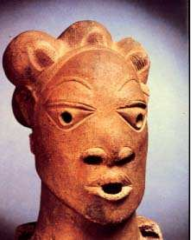
|
Artist/Culture: Nok
Title: Nok Head Date: 500BC-200CE Medium: Terracotta Location/Culture of Origin: Nigeria |
Formal:
(1) Expressive face; large, alert eyes, flaring nostrils, & parted lips. (2)Pierced eyes, mouth, and ears (Nok sculpture character.); gender unknown (3) incised grooves, raised eyebrows, perforated triangular eyes, sharp jaw line; tube around neck suggest high position in society Cultural (1)Much is unknown about Nok sculptures except: Many found in diff positions (seated, standing, kneeling..etc), sculptor carved details of the head while modeling the rest, person portrayed most likely had elevated pos. |
|
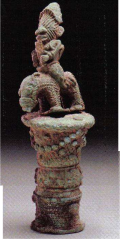
|
Artist/Culture: Igbo-Ukwu
Title: Equestrian Figure on Fly-Whisk Hilt Date: 9th-10th c. Medium: Bronze Location/Culture of Origin: Nigeria |
Formal:
(1)Lost wax cast bronze; figure seated on horselike animal; rider's head exaggerated size; facial stripes (titled status) (2)Bottom half is an elaborately embellished handle w/beaded & threadlike patterns Cultural (1)Handheld object made for leader to extend his reach & magnify gestures. (2) Influenced ideal of style in African art; elitist dreams |
|
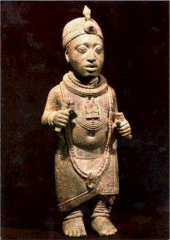
|
Artist/Culture: Ile-Ife
Title: King Date: 11th-12th c. Medium: Zinc Brass Location/Culture of Origin: Nigeria |
Formal:
(1)Naturalism: facial features(portraits) & fleshy anatomy; body proportions still off...head is much larger (2)Naturalistic to a point, same time is idealized: (ppl portrayed as:) young adults, blemish/signs of aging free, Cultural (1)Large head b/c head is the locus of wisdom, destiny, and the essence of being (2)large head=lots of above traits=royal |
|

|
Artist/Culture: Benin
Title: Royal Ancestral Alter of Benin King Eweka II Date: Photographed in 1920 Medium: Clay, copper alloy, wood, ivory Location/Culture of Origin: Nigeria |
Formal:
(1)Central altarpiece: depicts sacred king flanked by members of entourage; copper heads fitted on top with an ivory tusk carved in relief (2)Wood staffs and metal bells; Composition is hierarchical Cultural (1)Heads rep. both kings themselves & endurance of kingship. Red surface signals danger and repels evil forces. (2)Elephant tusk relief commemorate important events in history. White color= purity & goodness. Wood staffs refer to generations of ancestors. (3) Bells call royal ancestors spirits to rituals. |
|
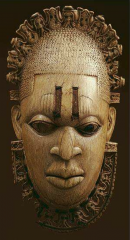
|
Artist/Culture: Benin
Title: Waist Pendant of a Queen Mother Date: 1520 Medium: Ivory and Iron Location/Culture of Origin: Nigeria |
Formal:
(1)Naturalistic features of Idia (kings mother); broad forehead and nose, bulging eyes. (2)hairline crown has alternating Portuguese heads and mudfish; bottom adorned by Portuguese heads as well Cultural (1)Symbolic allusion to Benin's trade/diplomatic relationship w/Portuguese (and Olokun, god of the sea--mudfish) (2)Made for the Oba |
|

|
Artist/Culture: Dogon
Title: Seated Couple Date: 1800-1850 Medium: Wood Location/Culture of Origin: Mali |
Formal:
(1)Idealized. Male on right; arm around female, pointing at phallus, facial hair, helmet, quiver on back. (2)Idealized. Female on left; breasts, patterns on stomach, braided hair, ornament on face, child on back. (3) appears to have people holding up the seat they sit upon (ancestors) Cultural (1) These were used in everyday households as well as elite houses; idea that you leave the alter at home to do prayers for you while you're out of the house (2)Made for people whenever they had a problem that required massive amounts of prayer (this one could be a young man who is ready to start a fam.--i.e. find a wife, have a child..etc) |
|
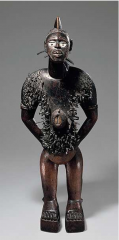
|
Artist/Culture: Kongo
Title: Nail Figure (Nkisi Nkondi) Date: late 19th c. Medium: Wood, nails, blades, medicinal materials, cowrie shells Location/Culture of Origin: Democratic Repub. of the Congo |
Formal:
(1)Relatively naturalistic, but simplified; man bristling with nails. (2)Wide starring eyes, meant to look as if at any moment he will be on his mission to hunt Cultural (1)Cast by a healer who inserts sacred substance; insert a blade/nail and activate sub.; evil spirits will come if you don't keep your side of deal (2)Idea was to ensure justice in society |
|
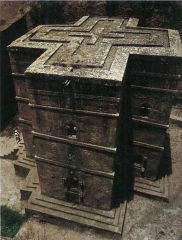
|
Artist/Culture: Zagwe
Title: Beta Giorghis (Church of St. George) Date: 13th c. Medium: Tufa Location/Culture of Origin: Ethiopia |
Formal:
(1)Greek cross cut out of the tufa rock ground; roof has greek cross sculpted in relief. Cultural (1) Shows influence of Christianity in Ethiopia (2)Also shows connection to contemporary Byzantine architecture |
|

|
Artist/Culture: Djenné
Title: Great Mosque of Djenné Date: 13th c. Medium: Adobe Location/Culture of Origin: Mali |
Formal:
(1)Adobe mosque; large courtyard, roofed prayer hall, facade featuring soaring adobe towers & vertical buttresses that look like engaged columns (2)many rows of protruding wooden beams; decorative and practical (for workers to re-furbish building every year) Cultural (1)Great Mosque at Djenne has a huge impact on the community for which it employs. Provides jobs (brick building) for poor, tourism, and religious needs (2)opposing views on if they should start using cement tiles to rebuild b/c mud brick melts, but tile doesn't; tile isn't the traditional way though. |

